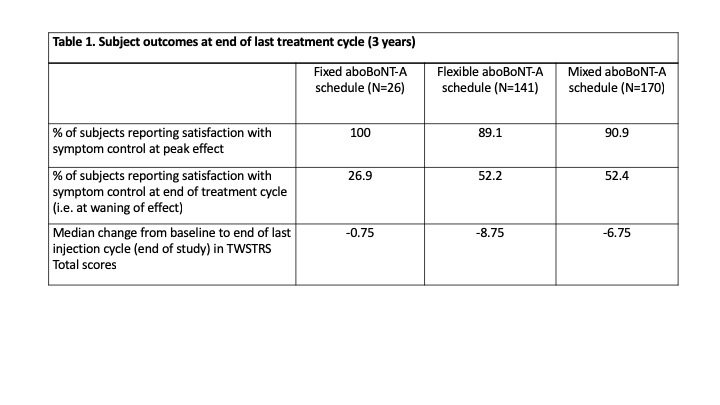Session Information
Date: Tuesday, September 24, 2019
Session Title: Dystonia
Session Time: 1:45pm-3:15pm
Location: Les Muses Terrace, Level 3
Objective: This post-hoc analysis assessed the impact of fixed or flexible injection schedules on outcomes in patients receiving abobotulinumtoxinA (aboBoNT-A) for cervical dystonia (CD) in routine practice.
Background: Primary analyses of the INTEREST IN CD2 study indicated that satisfaction with botulinum neurotoxin type-A (BoNT-A) symptom control remains relatively constant over 3 years. Predictive factor analyses showed that subjects with more severe CD (higher TWSTRS Total scores) are less likely to be satisfied, both at peak effect and end of cycle. In addition, subjects with shorter treatment intervals were also less likely to be satisfied with their symptom control. In routine practice, BoNT-A clinics are often run according to fixed or flexible injection intervals.
Method: INTEREST IN CD2 (NCT01753349) was a 3-year observational study following people with CD treated with BoNT-A. A survey was sent to study sites to ascertain whether they reinjected according to: fixed re-injection intervals (hospital rules/usual practice), a flexible schedule (depending on patient needs) or a mix of both. Study outcomes for subjects using aboBoNT-A were reanalysed by subgroup.
Results: 61 of 113 active sites completed the survey, allowing post-hoc analysis for 337 subjects treated with aboBoNT-A. Of these, 26 subjects (7.7%) were treated according to fixed schedules (median aboBoNT-A dose: 414U, median interval: 14.1 weeks), 141 (41.8%) had flexible schedules (dose: 500U, interval: 15.3 weeks) and 170 (50.4%) had mixed schedules (dose: 525U, interval: 15.9 weeks). While rates of satisfaction at peak effect were similar between groups, subject satisfaction at end of treatment cycle (i.e. at waning of effect) looked higher for subjects with schedule flexibility versus those with fixed schedules [Table1]. Differences in the change from baseline TWSTRS scores were also apparent between flexible and fixed groups at the end of the last treatment cycle.
Conclusion: Subjects with flexibility in their aboBoNT-A injection schedules to meet patient needs had injection intervals of 15.3 weeks. This injection interval was longer than for the fixed schedule group (limited in sample size) and, in line with the primary analysis, was associated with better patients benefits even at the end of an injection cycle.
To cite this abstract in AMA style:
C. Colosimo, T. Chung, D. Charles, V. Misra, S. Om, P. Maisonobe. Impact of fixed or flexible abobotulinumtoxinA injection intervals on patient outcomes: Analyses from a 3-year observational study following patients with cervical dystonia [abstract]. Mov Disord. 2019; 34 (suppl 2). https://www.mdsabstracts.org/abstract/impact-of-fixed-or-flexible-abobotulinumtoxina-injection-intervals-on-patient-outcomes-analyses-from-a-3-year-observational-study-following-patients-with-cervical-dystonia/. Accessed December 20, 2025.« Back to 2019 International Congress
MDS Abstracts - https://www.mdsabstracts.org/abstract/impact-of-fixed-or-flexible-abobotulinumtoxina-injection-intervals-on-patient-outcomes-analyses-from-a-3-year-observational-study-following-patients-with-cervical-dystonia/

